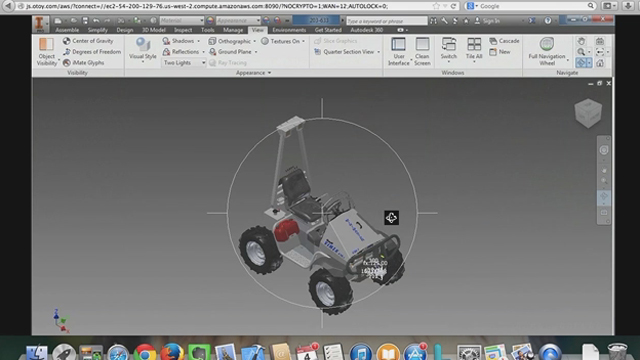Latest News
November 7, 2013
If the transition of 3D design capabilities to the cloud has been a series of measured steps, think of Autodesk’s latest move as a leap for CAD.
Autodesk, which has been the most aggressive of the CAD vendors to embrace the new software delivery paradigm, has announced a technology preview of full-fledged versions of its 3D design, engineering, and entertainment tools running in a Web browser for the first time. These browser-based versions of Autodesk Inventor, Revit, Maya, and 3ds Max provide access to the bulk of functionality in the traditional desktop versions on any Internet-connected system or device without requiring a full license of the program, and without keeping the user tied to any specific PC.
Central to Autodesk’s announcement are long-standing collaborations between a trio of industry players. Amazon Web Services (AWS) just announced a partnership with NVIDIA whereby it will add GPU-based acceleration services (dubbed G2), based on NVIDIA’s GRID technology, to its scalable infrastructure, making it available for Software-as-a-Service (SaaS) products like the one Autodesk will offer. Another key piece of Autodesk’s ability to put Inventor in the cloud results from its on-going work with OTOY, which makes technology that addresses the latency and fidelity challenges related to providing a rich and interactive 3D experience in a remote environment.
Jeff Kowalski, Autodesk’s chief technology officer, says the announcement signals the next logical chapter in Autodesk’s on-going migration to the cloud. “When we started the cloud initiative a number of years ago, we went to things people couldn’t do on the desktop at all—simulation, rendering, and collaboration—and put those in the cloud first,” he explains. “Then we went to new kinds of design experiences that should be cloud-first like Fusion 360. The (next) step is to provide more flexibility and agility to users who still are tied to desktop products.”
Putting 3D CAD tools like Inventor in the cloud has been a challenge seven years in the making, Kowalski says. The central issue has been how to address the low-latency and high-fidelity requirements that are central to providing a rich, interactive 3D modeling experience. “With CAD, the graphics requirements are so intensive—all the pixels are on the screen at once and in engineering, every line matters,” he explains. “People want to feel they are really connected to the computer even though the computer is really at a distance.”
Until AWS and NVIDIA’s announcement of G2 and the work Autodesk has done with OTOY, the foundation wasn’t there to support graphics-intensive processing requirements. “Up until now, we didn’t have the scalable, elastic form of computing that could support the graphics requirements of our product,” Kowalski says. “You could run Word in the cloud using remote technology, but you couldn’t run Inventor without a GPU.”
While the NVDIA/AWS partnership around G2 solves the GPU piece of the puzzle, OTOY’s streaming technology addresses the challenges around low-latency, high-fidelity remote access. The pair began working together on Autodesk Remote, announced earlier this year. Autodesk Remote allows existing Autodesk Inventor, Revit, Maya, and 3ds Max users to access the desktop version of their software from another device—be it an iPad on the shop floor or another laptop at home. The latest announcement builds on that effort, allowing users who don’t own Inventor or have access to a high-powered desktop system to tap into CAD services from any browser-based device, without installing software.
“Ninety percent of all software is now available in the cloud, but the last 10% is graphics software,” says Jules Orbach, OTOY’s CEO. “Now you can treat graphics, CAD, and gaming like any other Web service.”
The Autodesk software is currently a technology preview available to developers with Amazon credentials to test drive and provide feedback, Kowalski says. There is no set time frame for its release, and pricing and delivery details are still being worked out. Watch this video to get a preview of how the technology works.
Subscribe to our FREE magazine, FREE email newsletters or both!
Latest News
About the Author
Beth Stackpole is a contributing editor to Digital Engineering. Send e-mail about this article to [email protected].
Follow DE






